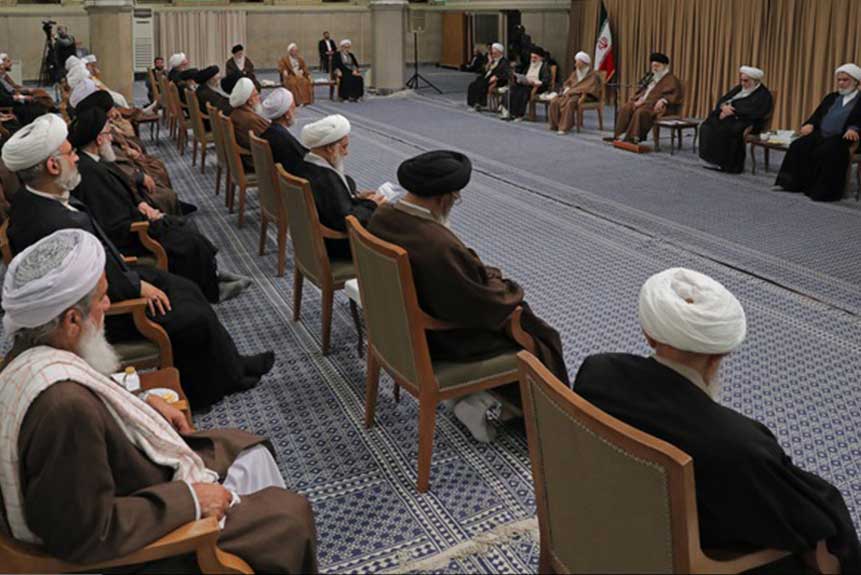
Iran’s Supreme Leader Hints at His Own Succession
By Michael Rubin
“There will be no pause or interruption in the system….”
On 7 November 2024, Iran’s Ayatollah Ali Khamenei, who is 85 years old,[i] appeared before the 88-member Assembly of Experts, a clerical body charged with selecting the new supreme leader, to discuss—obliquely but still more directly than ever before—his own succession. Published on his official website, Khamenei.ir,Khamenei’s speech discussed the possibility of his own “absence” and the need for a rapid transition. While his comments were oblique, they nevertheless represented the bluntest discussion of an increasingly sensitive subject. To hint at his own mortality and the looming succession risks not only transforming Khamenei himself into a lame duck but can also be destabilizing as regime officials begin to maneuver for the post-Khamenei scramble.
Whenever it occurs, the leadership transition in Iran will have an important impact on the operational environment, because, constitutionally, the supreme leader is also the commander-in-chief with authority to hire and fire military commanders in both the Revolutionary Guard and the regular Iranian Army. The speed of succession could also affect both domestic and regional stability. Quick acceptance of a new leader lessens the chance of domestic unrest. However, there is the risk a new leader may resort to military action, terrorism, or through proxies, to establish his revolutionary bona fides. One major question is whether Khamenei’s successor will launch a cultural revolution to try to tamp down dissent in a way that could lead to a public backlash and exacerbate unrest.
Beyond nods to his succession, Khamenei’s speech included other notable takeaways. While Khamenei has previously voiced concern about declining revolutionary fervor among Iranian youth, the speech was also the first time that Khamenei raised the possibility that the gains that resulted from the 1979 Islamic Revolution could be reversible.[ii] Khamenei also criticized former Soviet Premier Joseph Stalin for allowing the Soviet experiment to descend into dictatorship at the expense of “communist democracy,” but does not appear self-aware that many within Iranian society see him as a dictator and that Iran as a regime has betrayed its promised values: chants of “death to the dictator” during last year’s “Woman, Life, Freedom” are one example of this public sentiment.
Sources:
“بیانات در دیدار اعضای مجلس خبرگان رهبری”(Statements in the Meeting of the Assembly of Experts),” Khamenei.ir (official website of Iranian Supreme Leader Ali Khamenei), 7 November 2024. https://tinyurl.com/48rfb7rj
Within the structure and general framework of the Islamic system, the primary role of the Leader is to ensure that the system’s orientation is directed toward the goals of the Revolution. This is the main responsibility of the Leader. The Revolution took place for a purpose. Of course, all revolutions have goals. They have fundamental goals that lead them to reshape and transform the order of life… [Those opposed to revolution] were able to prevent [previous] revolutions from achieving their goals and reverse their course. For instance, in the great French Revolution, which was one of the most significant revolutions in our contemporary history, barely 15 years had passed since the start of that revolution when the previous authoritarian monarchy and dictatorship were reestablished. All the efforts of the people, the endeavors of renowned French intellectuals, the efforts and struggles of the masses, the casualties, the massacres, the conflicts — all of these were essentially nullified and destroyed in less than 15 years!
A similar but worse case was what happened to the Soviet Revolution, which was also another major revolution. There too within less than a decade, the claims, the rhetoric, the professed justice and so-called “communist democracy” all vanished. A dictator, a ruthless tyrant like Stalin, seized power and that was the end of it. So this is a risk that all revolutions face.
The Quran repeatedly emphasizes and warns about this matter, not just once or twice, but perhaps tens of times. The holy verses of the Quran repeatedly speak about regression and returning to the previous state from which people had been liberated and saved. This warning is directed toward both the believers and the unbelievers.
An element is necessary to prevent this [regression]. In the Islamic system, this element is the position of the Leader. Such a deviation must be prevented by a leader. This is very important. It is very important…! The establishment and creation of the Assembly of Experts signifies the uninterrupted progress of the Islamic system. This means that there will be no pause or interruption in the system. The Assembly of Experts exists to be able to designate a successor. Therefore, this succession will continue with full strength, power, and ability. This readiness and presence of the Assembly of Experts has such a meaning. If the current Leader were to be absent, the Assembly of Experts would immediately take action to select a successor. It is like this.
Notes:
[i] Ali Khamenei’s health struggles are not entirely secret: a 1981 assassination attempt left him partially paralyzed, and the regime photographed him in the hospital five years ago as he received treatment for prostate cancer.
[ii] For discussion of Khamenei’s concern about declining revolutionary fervor, see: Michael Rubin, “Iran’s Supreme Leader Warns of Declining Fervor of New Generation,” OE Watch, 08 2023. https://fmso.tradoc.army.mil/2023/irans-supreme-leader-warns-of-declining-fervor-of-new-generation/ . See also: Michael Rubin, “Iran’s Supreme Leader Speaks on Martyrdom” OE Watch, December 2021. https://community.apan.org/wg/tradoc-g2/fmso/m/oe-watch-past-issues/399678/download and Michael Rubin, “Khamenei Warns Veterans of Declining Revolutionary Fervor” OE Watch, February 2020. https://community.apan.org/wg/tradoc-g2/fmso/m/oe-watch-past-issues/310925/download
Image Information:
Image: Supreme Leader Ali Khamenei speaks to the Assembly of Experts in Tehran, 7 November 2024.
Source: https://idc0-cdn0.khamenei.ir/ndata/news/58257/C/14030817_0758257.jpg
Attribution: Khamenei.ir
Distribution A: Approved for public release
Categories:
Tags:







